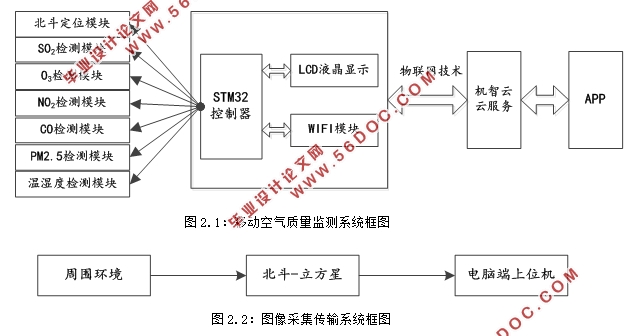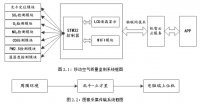基于北斗定位和物联网的移动空气质量监测系统设计(论文13000字)
摘要:大量城市出现了严重的雾霾天气,不仅危害普通大众的健康和正常旅行,而且,还会阻碍人们的正常生产和发展,并受到了越来越多的关注。随着对大气污染问题的的日益关注和重视,对大气污染的实时监测变得越来越重要,通过监测污染的情况和原因,我们可以制定相应的有效解决方案。在了解国内外空气和环境检测的发展的基础上,考虑了各种空气检测方法的优缺点,设计和实现了具有北斗定位和物联网远距离传输的移动空气质量检测系统,可以安装到移动平台上面,通过移动平台的移动和北斗-立方星,能够实现对各地空气质量数据和周围环境图像的实时采集,包括温湿度数据以及PM2.5、CO、SO2 、O3 、NO2 等有害气体浓度数据,并在液晶屏上实时显示出来。物联网技术用来将收集的数据上传到机智云平台,移动终端APP可以通过云服务查询空气质量数据,通过及时准确的数据和发展的趋势,建议可行的防范措施。
关键词:空气质量;北斗定位;北斗-立方星;物联网;APP;
Design of Mobile Air Quality Monitoring System Based on Beidou Positioning and Internet of Things
Abstract:A large number of cities have experienced severe smog weather, which not only endangers the health and normal travel of the general public, but also hinders people's normal production and development, and has received more and more attention. With the increasing attention and attention to air pollution problems, real-time monitoring of air pollution has become more and more important. By monitoring the situation and causes of pollution, we can formulate corresponding effective solutions. On the basis of understanding the development of air and environmental testing at home and abroad, considering the advantages and disadvantages of various air detection methods, the mobile air quality detection system with Beidou positioning and IoT long-distance transmission is designed and implemented, which can be installed on the mobile platform. Above, through the movement of the mobile platform and the Beidou-Cube Star, real-time collection of air quality data and surrounding environment images, including temperature and humidity data, and harmful gas concentration data such as PM2.5, CO, SO2, O3, and NO2, can be realized. And displayed on the LCD screen in real time. The Internet of Things technology is used to upload the collected data to the wit cloud platform. The mobile terminal APP can query the air quality data through the cloud service, and propose feasible preventive measures through timely and accurate data and development trends.
Key words:Air quality; Beidou positioning;Beidou-Cubic Star; Internet of Things; APP;

目录
1.绪论 1
1.1研究背景 1
1.1.1引言 1
1.1.2空气污染的类型 2
1.1.3我国空气监测的技术现状 2
1.2本课题研究意义 3
1.3系统设计内容和创新点 3
1.3.1设计内容 3
1.3.2设计创新点 4
2.系统设计原理 5
2.1空气质量监测系统原理 5
2.1.1系统总体结构设计 5
2.1.2系统硬件总体原理设计 6
2.2北斗系统原理 6
3.系统的硬件设计 8
3.1主控单元 8
3.2LCD显示电路设计 9
3.3传感器的选择 9
3.3.1温湿度传感器 9
3.3.2 SO2传感器 10
3.3.3 O3传感器 10
3.3.4 CO和NO2传感器 11
3.3.5 PM2.5传感器 11
3.4北斗定位模块 12
3.4.1北斗模块的选用 12
3.4.2北斗模块与单片机的连接 12
3.4.3北斗模块测试配置软件 13
3.5北斗-立方星 13
3.5.1北斗-立方星的介绍 13
3.5.2北斗-立方星云台模块 14
3.6WiFi模块 15
3.7程序下载电路 15
4.系统的软件设计 16
4.1温湿度模块程序设计 16
4.2气体传感器模块程序设计 17
4.3北斗定位和PM2.5模块程序设计 18
4.4LCD显示屏模块程序设计 19
5.机智云物联网开发 21
5.1机智云的介绍 21
5.2数据透传 22
5.2.1实现功能 22
5.2.2硬件准备和配置 22
5.2.3软件设计 23
6.系统测试功能 25
6.1系统的硬件测试 25
6.2系统的数据远程传输测试 26
7.总结和展望 27
7.1论文的工作总结 27
7.2未来研究工作展望 27
参考文献 28
致谢 30
|



